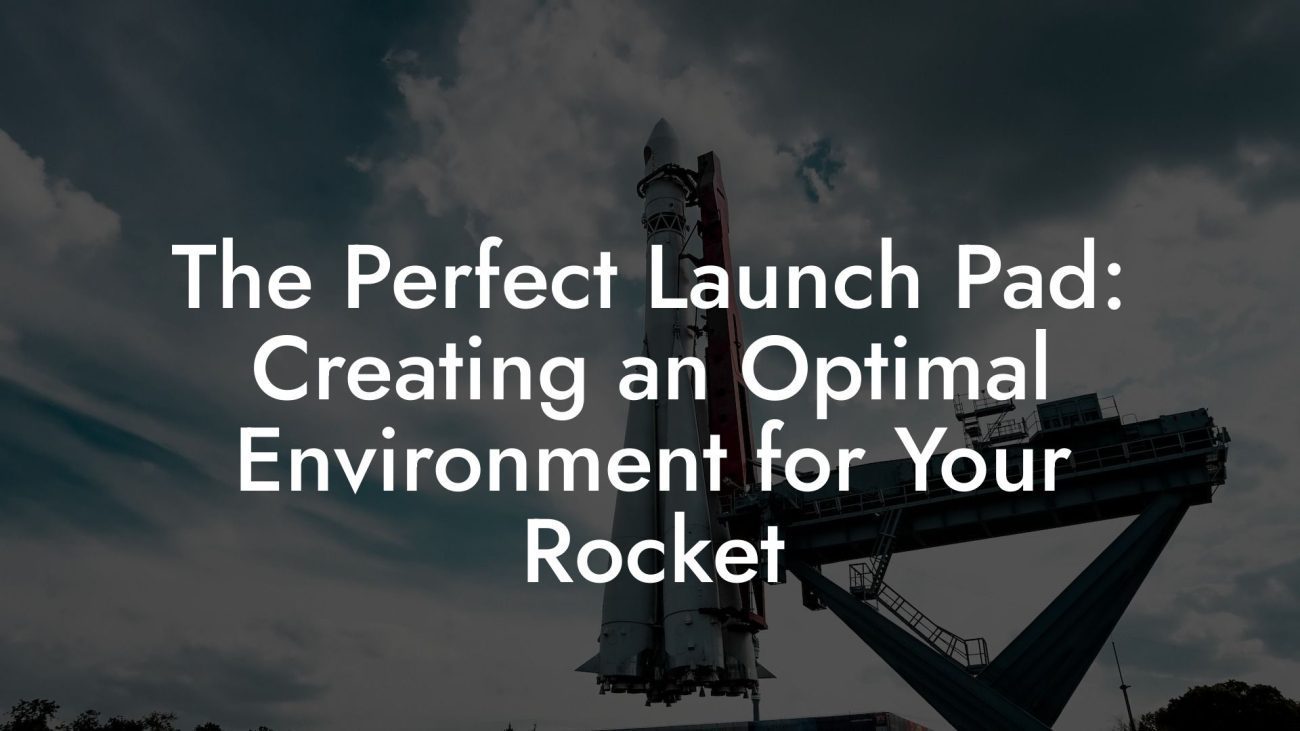Launch day is the culmination of countless hours of planning, designing, and testing, and it all comes down to a single, unforgettable moment of liftoff. "Launch Day Essentials: Pre-Launch Checklist for a Successful Flight" is your comprehensive guide to ensuring that every aspect of your launch is carefully prepared and executed with precision. From safety protocols and equipment checks to weather monitoring and final rocket inspections, this guide will walk you through everything you need to know to make your launch day as smooth and successful as possible.
Quick Links to Useful Sections
- Introduction: The Importance of a Thorough Pre-Launch Checklist
- Section 1: Pre-Launch Planning and Mental Preparation
- Define Your Launch Objectives
- Create a Detailed Timeline
- Mental Check and Team Coordination
- Section 2: Launch Site Selection and Preparation
- Finding the Perfect Location
- Assessing Environmental Conditions
- Setting Up Your Launch Pad
- Section 3: Rocket Assembly and Final Checks
- Pre-Launch Inspection of the Rocket
- Systematic Pre-Launch Testing
- Section 4: Safety Protocols and Emergency Preparedness
- Personal Protective Equipment (PPE)
- Emergency Procedures
- Section 5: The Countdown and Launch Execution
- Coordinated Countdown
- Ignition and Liftoff
- Section 6: Recovery: Bringing Your Rocket Safely Back Home
- Types of Recovery Systems
- Deployment and Retrieval
- Section 7: Post-Launch Analysis and Continuous Improvement
- Documenting Your Launch
- Reviewing Performance Metrics
- Team Debrief and Feedback
- Model Rocket Launch & Recovery FAQs
- Your Next Launch: Soar with Confidence and Precision
Introduction: The Importance of a Thorough Pre-Launch Checklist
Whether you’re launching your first model rocket or are a seasoned rocketeer, one thing remains constant: the success of your flight heavily depends on how well you prepare on launch day. A meticulous pre-launch checklist not only minimizes the risk of malfunctions but also maximizes your rocket’s performance and your overall enjoyment. This guide is designed to help you double-check every detail, anticipate potential issues, and create an environment where safety and excitement go hand in hand.
Launch day is more than just a countdown, it’s a carefully orchestrated event that demands attention to detail at every step. From assembling your launch pad and securing your rocket to monitoring the weather and conducting final system checks, every action plays a crucial role in ensuring a successful flight.
Section 1: Pre-Launch Planning and Mental Preparation
The foundation of a great launch day begins well before you arrive at your launch site. Mental preparation and strategic planning are as important as physical setup. Here’s what you should consider:
Define Your Launch Objectives
Start by clarifying your goals for the launch. Are you testing a new engine, aiming to break your altitude record, or simply enjoying a recreational flight? Your objectives will dictate many decisions, including the configuration of your rocket, the choice of recovery system, and even the ideal weather conditions.
Looking For The Best Model Rocket Kits? You'll Love These:
Create a Detailed Timeline
Develop a timeline that outlines every step of your launch day. This includes arrival time at the launch site, equipment setup, final rocket inspections, and the countdown. Having a well-structured schedule helps keep you organized and ensures that you don’t miss any critical tasks.
Mental Check and Team Coordination
If you’re launching with a team, hold a pre-launch briefing. Discuss roles and responsibilities, review safety protocols, and establish clear communication signals. A focused, well-coordinated team can make all the difference when unexpected situations arise.
Section 2: Launch Site Selection and Preparation
Choosing the right launch site is crucial for both safety and performance. The ideal location offers plenty of open space, minimal obstructions, and favorable weather conditions.
Finding the Perfect Location
Look for wide, open fields, designated launch sites, or remote areas free from trees, buildings, and power lines. A clear, unobstructed space ensures that your rocket can ascend without interference and that any debris or recovery devices have ample room to land safely.
Assessing Environmental Conditions
Weather plays a significant role in a successful launch. Check the forecast for:
- Wind Speed and Direction: Low wind conditions are ideal. Even moderate winds can alter your rocket’s trajectory or affect the deployment of recovery systems.
- Temperature and Humidity: Extreme temperatures can affect engine performance and fuel stability, while high humidity might impact the integrity of your rocket’s materials.
- Cloud Cover and Precipitation: Rain can interfere with both the engine and the recovery system. A clear, dry day is always preferable.
If conditions aren’t ideal, it’s better to delay the launch than risk a compromised flight.
Setting Up Your Launch Pad
A stable launch pad is essential for a controlled liftoff. Whether you’re using a commercial pad or building your own, ensure it’s firmly anchored, level, and free from obstructions. Your pad should include:
- A solid base: A flat, stable surface that won’t shift under the force of the launch.
- Launch controllers: Use a reliable electronic launch controller to safely ignite the engine from a safe distance.
- Safety barriers: Mark a safe perimeter around the launch area to keep spectators at a safe distance.
Section 3: Rocket Assembly and Final Checks
With your launch site ready, turn your attention to the final assembly and inspection of your rocket. This stage is all about ensuring that every component is securely in place and that the rocket is ready for liftoff.
Pre-Launch Inspection of the Rocket
Conduct a thorough visual and functional inspection of your rocket. Key points to check include:
- Engine Mounting: Verify that the engine is properly seated, securely fastened, and aligned correctly within the rocket body.
- Fuel and Recovery System: Ensure that the fuel is fresh and that the recovery system (parachute, streamer, etc.) is correctly packed and free of tangles.
- Structural Integrity: Look for any loose parts, cracks in the body, or imperfections that could affect the rocket’s performance.
- Adhesion and Fin Attachment: Double-check that fins and other appendages are firmly attached and aligned. Even minor misalignments can impact aerodynamic stability.
Systematic Pre-Launch Testing
Before moving to the launch pad, perform a few controlled tests:
- Static Engine Test: If possible, test the engine on a test stand to verify that it ignites properly and produces the expected thrust.
- Recovery Deployment: Test the recovery system by simulating the ejection charge to ensure that the parachute or streamer deploys as intended.
- Communication Checks: Ensure that your launch controller, countdown timer, and any tracking devices are functioning correctly.
These tests help catch any issues before they become critical during an actual launch.
Section 4: Safety Protocols and Emergency Preparedness
Safety is the cornerstone of any successful launch. Establishing and following strict safety protocols ensures not only your well-being but also the safety of those around you.
Personal Protective Equipment (PPE)
Make sure everyone involved in the launch wears appropriate protective gear, including:
- Safety goggles: To protect your eyes from debris and bright flashes.
- Gloves: To shield your hands from sharp objects or accidental burns.
- Hearing protection: In case of particularly loud launches.
Emergency Procedures
Develop and review an emergency plan with your team. This plan should cover:
- Steps to follow in case of an engine malfunction or unexpected rocket behavior
- Clear roles and responsibilities for each team member
- Emergency contact information and first aid procedures
Familiarize everyone with the plan before launch, and ensure that safety barriers and first aid kits are readily accessible.
Section 5: The Countdown and Launch Execution
With every detail checked and double-checked, it’s time for the countdown and liftoff. This is the moment where preparation meets performance.
Coordinated Countdown
Begin a clear, audible countdown that everyone can hear. A typical sequence might be:
- "10, 9, 8…"
- "7, 6, 5…"
- "4, 3, 2, 1…"
- "Launch!"
During the countdown, maintain constant communication with your team and verify one last time that all systems are go.
Ignition and Liftoff
At the moment of ignition, observe your rocket as it lifts off smoothly from the pad. Monitor its ascent closely:
- Engine Performance: Check for a clean, steady ignition and a robust burst of thrust.
- Trajectory: Ensure the rocket ascends vertically and follows the intended flight path.
- Recovery Activation: Confirm that the delay element triggers the recovery system at the appropriate altitude.
If any anomalies occur during launch, be prepared to implement your emergency protocols immediately.
Section 6: Recovery: Bringing Your Rocket Safely Back Home
A successful launch isn’t complete without a reliable recovery system to safely return your rocket. Recovery techniques vary, but the goal remains the same: protect your rocket and prepare it for future flights.
Types of Recovery Systems
The most common recovery systems in model rocketry include:
- Parachutes: Deploy via an ejection charge to slow descent and ensure a gentle landing.
- Streamers: Often used in smaller rockets, streamers provide a controlled descent with minimal drag.
- Hybrid Systems: Combine elements of both parachutes and streamers to optimize recovery for different flight profiles.
Deployment and Retrieval
Make sure your recovery system is properly packed and tested. During the flight, the ejection charge should deploy the recovery device at the right moment, allowing the rocket to descend at a controlled rate. Once on the ground:
- Track the Landing: Use visual cues or tracking devices (like GPS or radio beacons) to locate your rocket.
- Safe Retrieval: Approach the landing site cautiously and inspect the rocket for any damage.
- Post-Flight Check: Document any issues with recovery for future improvements and maintenance.
A reliable recovery system is essential not only for preserving your rocket but also for learning and making adjustments for subsequent launches.
Section 7: Post-Launch Analysis and Continuous Improvement
Every launch is a learning experience. After your rocket has safely returned to the ground, take time to review the entire process:
Documenting Your Launch
Record important details such as weather conditions, engine performance, flight trajectory, and recovery behavior. Detailed logs help identify what worked and what needs improvement.
Reviewing Performance Metrics
Analyze data from test launches, high-speed video footage, and any sensor readings you have. Compare these with your expected performance metrics to pinpoint areas for optimization.
Team Debrief and Feedback
Gather feedback from your team to discuss the launch’s successes and challenges. Use this collective insight to refine your pre-launch checklist and improve your overall process.
Continuous improvement is the key to long-term success in model rocketry. Each launch, whether flawless or flawed, provides valuable data that can guide your future endeavors.
Model Rocket Launch & Recovery FAQs
Here are some frequently asked questions to help you troubleshoot and optimize your launch and recovery processes:
1. What are the most critical steps during launch preparation?
Choosing a safe, open launch site, conducting thorough equipment checks, and following a detailed pre-launch checklist are key steps to ensure a successful launch.
2. How can I improve my rocket’s launch stability?
Ensure that your rocket is securely mounted on a stable launch pad, that all components are aligned properly, and that you maintain consistent environmental conditions during the countdown.
3. What types of recovery systems work best for model rockets?
Parachutes and streamers are the most common recovery systems. The best choice depends on your rocket’s size, altitude, and desired descent rate.
4. How do I know if my recovery system has deployed correctly?
A properly deployed recovery system will fully unfurl and slow the rocket’s descent. If the rocket lands too hard or appears damaged, it may indicate a problem with deployment.
5. What role does weather play in the success of a launch?
Weather conditions such as wind, rain, and temperature significantly affect both launch stability and recovery. Always monitor the forecast and adjust your plans accordingly.
6. How can I safely retrieve my rocket after landing?
Use tracking devices or mark the landing area to locate your rocket, then approach carefully and inspect it for any damage before handling.
7. What should I do if my rocket fails to deploy its recovery system?
Follow your emergency retrieval procedures, wait for the rocket to land, and analyze the failure to improve future recovery system deployment.
8. Are tracking devices necessary for recovery?
While not always necessary, GPS trackers or radio beacons can greatly assist in locating your rocket, especially in high-altitude or remote launches.
9. Why is post-launch documentation important?
Detailed documentation helps you understand the performance of your launch, identify areas for improvement, and refine your techniques over time.
10. What common mistakes should I avoid during launch and recovery?
Avoid poor site selection, inadequate safety measures, improper engine alignment, and insufficient recovery system checks by planning meticulously and following a detailed checklist.
Your Next Launch: Soar with Confidence and Precision
With a comprehensive pre-launch checklist, a secure launch site, and a well-practiced recovery plan, your rocket is poised for success. Every step you take, from meticulous planning and assembly to the thrilling moment of liftoff, brings you closer to mastering the art of rocketry.
Embrace these launch day essentials, trust in your preparations, and let your rocket fly with the assurance that every detail has been covered. Your next launch is not just a test of technology but a celebration of your passion, precision, and perseverance.
The sky is not the limit, it’s just the beginning of your journey. So gear up, stay focused, and launch with confidence!
Looking For The Best Model Rocket Kits? You'll Love These:
Useful Interruption: Dive deeper into the world of Model Rockets with our most popular sections. If there is anything you think is missing or anything you would love for us to write about, just give us a shout.
- Getting Started & Basics With Model Rockets
- Model Rocket Design, Build & Customization
- Model Rocket Propulsion & Engine Technology
- Model Rocket Launch Techniques & Recovery
- Model Rocket Advanced Rocketry & Innovations
- Model Rocket DIY and Customization
- Model Rocket Equipment Reviews & Digital Tools
- Community, Competitions & Education
- Model Rocket Troubleshooting & FAQs
- Model Rocket Bonus/Seasonal & Niche Topics
A group of model rocket enthusiasts gathered at a field for their weekly launch event. Among them was Dave, a seasoned builder known for pushing the limits of hobby rocketry. This time, he had outdone himself.
“Ladies and gentlemen,” Dave announced, dramatically pulling a cloth off his latest creation, “I present to you: The Kraken!”
The crowd gasped. This wasn’t just a model rocket, it was a monster. The thing stood 8 feet tall, had six clustered engines, and was covered in enough duct tape to qualify as a classified aerospace project.
“Dave,” muttered Steve, the cautious safety officer, “Have you, uh… done the math on this?”
“Math?” Dave scoffed. “I built it in my garage at 3 a.m. with parts from eBay. This is an art piece, Steve.”
The countdown began.
5…
4…
3…
2…
1…
The engines ignited with a BOOM, and The Kraken shot up… kind of. It immediately did a violent barrel roll, narrowly missing the spectators before skyrocketing at an angle that could only be described as “legally questionable.”
The crowd collectively ducked as The Kraken flew straight over the adjacent cornfield, where Old Man Jenkins, the grumpiest farmer in town, was minding his business.
KABOOM!
The rocket disappeared behind the barn. A moment later, a flaming piece of Estes igniter wire landed at Steve’s feet. The silence was deafening.
And then, an unmistakable sound echoed across the field.
Jenkins’ shotgun being cocked.
“DAVE!!!” Steve shouted. “RUN.”
And that was the day Dave invented the first-ever biologically powered rocket booster: pure adrenaline.
To this day, nobody knows where The Kraken landed, but legend has it, it still haunts the skies, terrifying unsuspecting drones and low-flying birds.










